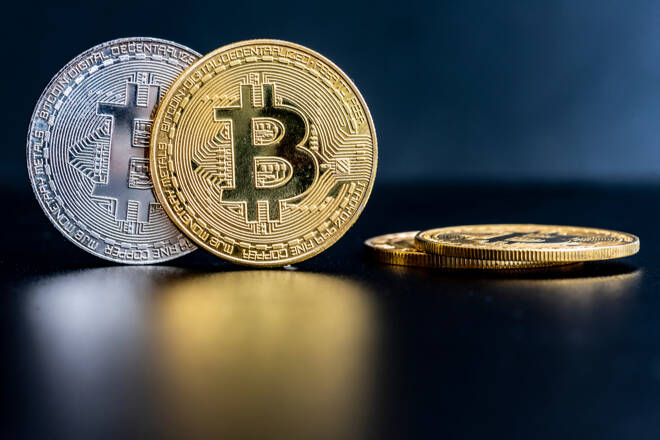Advertisement
Advertisement
Bitcoin Prices Forecast: Fed Fear and a Hot US Economy Rattle BTC
By:
A hot US economy intensified September Fed rate hike fears, leading to sharp losses in BTC and major US indices ahead of the Fed minutes later today.
Key Insights:
- On Tuesday, Bitcoin (BTC) fell by 1.52% to end the day at $29,406.
- US retail sales jumped by 0.7%, reigniting fears of a September Fed rate hike.
- Hawkish Fed minutes may pressure BTC further later today.
On Tuesday, bitcoin (BTC) fell by 1.52%. Reversing a 0.93% gain from Monday, BTC ended the day at $29,406. BTC ended the day at sub-$29,500 for the first time in nine sessions.
Bitcoin (BTC) Price Actions
This morning, BTC was down 0.05% to $29,390. A mixed start to the day saw BTC rise to an early high of $29,459 before falling to a low of $29,382.
Daily Chart
The Daily Chart showed BTC sitting below the $30,750 – $31,250 resistance band. After the bearish Tuesday, BTC sat below the 50-day EMA while holding above the 200-day EMA, sending bearish near-term but bullish longer-term price signals.
Looking at the 14-Daily RSI, the 44.68 reading reflects bearish sentiment. The RSI signals a return to sub-$28,500 to bring the $27,500 – $26,850 support band into view. However, a move through the 50-day EMA would give the bulls a run at the $30,750 – $31,250 resistance band.
4-Hourly Chart
Looking at the 4-Hourly Chart, BTC remains below the $30,750 – $31,250 resistance band. After the Tuesday pullback, BTC sits below the 50-day and 200-day EMAs, affirming bearish near-term price signals. Significantly, the 50-day EMA converged on the 200-day EMA. A bearish cross would bring sub-$28,500 and the $27,500 – $26,850 support band into view.
The 14-4H RSI reading of 37.19 reflects bearish sentiment, with selling pressure outweighing buying pressure. Significantly, the RSI aligns with the EMAs, bringing sub-$28,500 and the $27,500 – $26,850 support band into view.
Price action today will hinge on SEC-related news and the FOMC meeting minutes.
A Hot US Economy and Fed Fear Sends BTC into Negative Territory
On Tuesday, US retail sales figures impacted market sentiment across the riskier asset spectrum. US retail sales figures signaled a hot US economy. In July, US retail sales increased by 0.7% versus +0.3% in June, with core retail sales up 1.0% in July versus +0.2% in June. Economists forecast retail sales to climb by 0.4% and core retail sales to fall by 0.3%.
While the latest figures removed the fear of a hard landing, the retail sales numbers for July reignited fears of a September Fed rate hike. According to GDPNow, the GDP estimate from the Federal Reserve Bank of Atlanta, the US economy is forecast to grow by 5.0% in Q3, up from 4.1% one week earlier.
The US equity markets also responded to the unexpected jump in spending. The S&P 500 fell by 1.16% on Tuesday. It was also a bearish session for the Dow and the NASDAQ Composite, which saw losses of 1.02% and 1.14%, respectively.
Spot BTC ETF Uncertainty Remained a Headwind
While Fed Fear weighed, FUD did the rounds. Reports of the SEC pushing the decision on spot BTC ETFs to 2024 required investor vigilance. Comments from former SEC Chief John Reed Stark from the weekend and the SEC delay in approving the Ark Invest spot BTC ETF most likely contributed to the reports of pushback to 2024.
On Sunday, John Reed Stark shared his views on the likelihood of the SEC approving spot BTC ETFs, saying,
“My take is that the current SEC will NOT approve a bitcoin spot ETF application for a range of compelling reasons.”
However, Stark went on to say,
“However, I also believe that the crypto-regulatory tides could shift exponentially after Election Day.”
If Stark’s view proves true, the SEC may use delay tactics by giving other parties opportunities to provide the SEC reasons to decline the ARK Invest spot BTC ETF application, among others.
The Day Ahead
It is a busier Wednesday session, with the US economic calendar in the spotlight. After the market reaction to the US retail sales figures, the FOMC meeting minutes will move the dial.
Hawkish minutes would weigh on BTC and the broader market.
However, SEC v Ripple-related chatter, ETF updates, and Binance and Coinbase (COIN)-related news will move the dial.
US lawmaker chatter and SEC activity would also need consideration after the Amicus Curiae brief filings. Investors should also look out for any Court response to the request to dismiss the case.
About the Author
Bob Masonauthor
With over 28 years of experience in the financial industry, Bob has worked with various global rating agencies and multinational banks. Currently he is covering currencies, commodities, alternative asset classes and global equities, focusing mostly on European and Asian markets.
Advertisement
